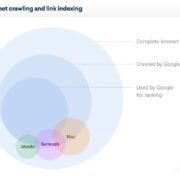Content-Does this sound familiar to you?
Publishing new articles regularly (the emphasis is on publishing, not writing) feels idle, and my backlog is growing steadily; the perceived “mountain of work” also. As if I hadn’t had enough of that outside of my blog. When did a hobby become work at all?
As a result, the frequency of publications is falling (observation), and some indicators are stagnating or are trending downwards (evaluation). Depending on the objective, maybe an alarm signal (interpretation).
Consequently, there is less responsiveness, and I get less feedback on my work; nobody can talk about it where there is nothing. But it is precisely the exchange and the secure feeling of supporting others in their work (or their hobby) with my work that makes up a large part of my motivation ( more on this here ).
Does that sound familiar to you?
You are not alone with this!
Today, eight years later, I take up this idea again because I have not followed my advice in the past few months and am experiencing the consequences described.
The cause is quickly identified and relatively simple:
Our quality standards prevent us from regularly offering our audience valuable Content.
The quality of our Content is a success criterion in content marketing, but who defines “quality”?
Tool providers who recommend more and more relevant based on competition analysis (for whom?) Terms that we should include in our texts? Google and other search engines, whose (non-transparent) algorithms suggest that FAQ boxes and other types of special markups are essential? Supposed experts, who generally recommend integrating as many audiovisual media as possible?
If we give up the definition of quality in this way, a vicious circle arises:
A good idea that theoretically offers consumers a lot of added value in the form of a short text (for example, food for thought, as I want to do with this article), is inflated further and further and becomes a Herculean task in production:
- Which keywords are lucrative?
- Have we checked the semantic environment through a term analysis?
- How does this fit into our topic clusters?
- What is the competition writing about?
- How good is the legibility?
- Which images can we integrate?
- Are there experts we can quote?
And so on.
The time until our idea generates real added value for our audience (we speak of “time-to-value” here) increases.
A growing “cemetery of ideas,” half-finished texts (ergo, waste of working time because our audience never gets to see anything), and a dispassionate presentation are the consequences.
I have already used terms such as “10X Content” and – obviously misleading – brought them in connection with the scope of Content, which is essentially about the effect of Content and the added value it creates.
Value versus quality.
If you read these two terms, you may see a small but subtle difference: Value creation considers the audience ( what reaction does our Content generate in readers? What do they feel? What do they think? And what do they do? ).
We are completely independent of quality, only to define us by at least 3,000 words, two images, and a keyword coverage of 80%.
To avoid that our quality standards stand in the way of our success through Content (marketing), in my opinion, we can do two things in particular:
- Value over Quality: Focus on the added value for the target group
The answer to how long texts have to be is, in most cases: As long as needed, as short as possible.
For readers, it is completely irrelevant how long or extensive an article is (analogous to podcasts, videos, presentations, etc.). The information content and the information density are important. The easier it is for consumers to find the important information, the better. Every word, every sentence, every picture that does not add value is superfluous.
A simple way to ensure this user focus is to use user stories or job stories.
Design content based on user stories
You may know user stories from agile methods like SCRUM.
The classic format is: “As a [type of user], I want [an action] so that [result].”
You can find an example directly on the cover of Sarah Winters’s (née Richards) book “Content Design.”
As someone who writes for the web, I want to learn what content design is and how to start doing it to communicate in the most user-centered and efficient way for my audience.
The approach is good and better than without, as it complements the user perspective. But there is legitimate criticism:
- When we formulate a task in this format, there is often not enough space to ask “why.” User stories may too concretely intend a specific solution, but we don’t know whether this is the best.
- User stories may be too specific to appeal to an entire audience. It means that one solution (or action to stick to the terminology) may work for some target groups but less for others. And suddenly, we need quite a few user stories.
User stories help to work user-centered but have some weaknesses (source: jtbd.info)
Content-based on job stories (jobs to be done)
The alternative is to focus on the situation, the motivation, the goal, and the intended result with the help of so-called job stories.
Job Stories, as used in the jobs-to-be-done method, can be applied to a wider audience because they are persona-unspecific, and: jtbd.info)
Job stories are great because they force us to think about the context instead of immediately sketching out solutions. It paves the way for creative or at least alternative solutions; And it doesn’t matter who the user or users are: in (i.e., they are not persona-specific) because they all want to do the same job.
- Publish early, optimize more often and learn faster
We can transfer the idea of a “Minimum Viable Product” (MVP for short) from the Lean Startup method to Content: Starting with the question of what we want to publish Content for, we focus on the actual goal.
I often hear something like, “We want to rank first in Google search results” – but why? What do we get out of it? We generate more organic traffic to our website” – okay, but why? “So that users become aware of our products” – aha! We can stop here for now.
Users. Products. Attention. That’s what it’s about.
Google rankings don’t have anything to do with the actual goal.
And now it is hopefully clear: there is not just one way to achieve this goal. You don’t necessarily need a comprehensive guide adorned with pictures that costs five days of production time (or even more).
The “Not done yet!” -thought is the death of any content idea, no matter how good it is.
Instead of defining a minimum of 3,000+ words for a new blog article, integrating 43 keywords and search phrases, or directly creating 12 images for this, we start with the “smallest for users: internally valuable” form. It can be a simple, short text that answers questions. Or an infographic that visualizes the information you are looking for. It is even just a tweet or a LinkedIn survey to find out in the first place whether there is any interest in “our” topic.
Use polls (here on LinkedIn) to prioritize your ideas
Fun fact: I would probably have written about text design first and content design tools without this survey. It is how it works.
A “quick” paid media campaign via LinkedIn, Google & Co. could also lead to the goal – faster, cheaper, and with one big advantage:
We learn what works and what doesn’t. With the help of various assets (creatives, texts, ad formats), targeting options, and distribution channels, we can test Content and measure exactly where the response is strongest.
We can build on that.
Nothing is worse than letting good ideas wither away because we are too vain to share them “unvarnished” with the public.
Iteration- an example
The first version of Ryte’s article on Keyword Monitoring was 712 words and four figures. The current version includes 1,538 words ( +116% ) and ten pictures ( +150% ).
Over time, for example, we supplemented a table of contents with jump labels and the associated structure of the text with subheadings. Both were only “necessary” due to the expanded scope.
We can assess whether such changes also lead to ranking improvements employing a before-and-after analysis. However, the more exciting question is whether the user intention serves better and users are more likely to convert as a result, for example. But Ryan will certainly keep this secret well. 😉
The knowledge that we acquire in this way can apply to all of our work.
Generally, if we can read from our advertisements that those advertisements that contain superlatives adopt a dominant tone of work better, then we can conclude (ergo formulating a new hypothesis) that our target group may be primarily – based on this who are Limbic® Types – Performers. We can, in turn, take this into account when designing our website and writing our future blog articles and improve their effectiveness from the start.
Do you understand the principle ?!
Customer-centered and iterative – this is how the creation of successful Content happens.
No keyword research, no WDF * IDF analysis, and no competition analysis either.
I just wrote and published this post. Okay, I created the picture with the example for content optimization, especially for this article. Still, it didn’t take me much time (made with Google Presentations, but please don’t tell Adobe). It was more important to get the message out as quickly as possible: Don’t let your Content die in beauty, but be courageous and publish it in an “unfinished” state. Consumers: inside won’t necessarily rate it negatively – how should they know what kind of awesome shit you were planning?
Your Content must represent added value.
And you don’t make that decision.
For example, the following message reached me after this article was published:
Hello Robert, I am currently reading your article “Why your quality standards harm your content marketing and how you can do it better” in your blog. You hit my point exactly. Or we are stuck in the loop of perfection and do not publish. 🙁 You break down walls of thought, beliefs, and rigid behavioral patterns. Thank you very much!
You also call us to get in touch if you want to learn more about the users and & job stories. I know user stories from Scrum. But like them, when creating Content can help; that’s what I’m hearing from you for the first time. If you’d like to go into the subject, I’d be very happy.
For me, this is confirmation on several points:
- The topic is relevant, and it hits a nerve of our time.
- This form of Content starts conversations – and who knows, maybe “business” as well.
- Such feedback enables me to validate other (Content) ideas before investing time or money in them.
It is how value creation works!
So, Work user-centered, focus on the smallest possible added value (for your users: inside but of course also for you and your business) and take the shortest route to deliver it.
It will make it easier for you to publish regularly.
We will then see everything else.
Or do you have another opinion?



















Comments